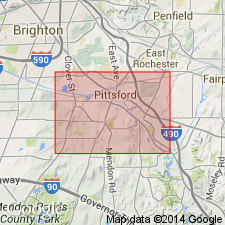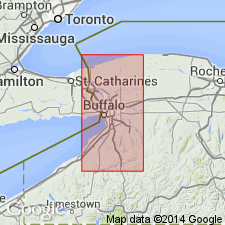
- Usage in publication:
-
- Pittsford shale
- Modifications:
-
- Named
- Dominant lithology:
-
- Shale
- Dolomite
- AAPG geologic province:
-
- Appalachian basin
Summary:
Distinctive layer of black shales at base of Salina shales exposed by excavations in Erie Canal near Pittsford, Monroe County, here named Pittsford shale. Contains unique collection of heretofore unknown fossils. Consists black shale and interbedded platten dolomite with profusion of eurypterids. Underlies Vernon shale; overlies Guelph Dolomite. [See also Clarke (1903, New York State Museum Handbook 19) and Sarle (1903, New York State Museum Bull. 69).]
Source: GNU records (USGS DDS-6; Reston GNULEX).

- Usage in publication:
-
- Pittsford Bed
- Modifications:
-
- Revised
- AAPG geologic province:
-
- Appalachian basin
Summary:
Author disagrees with Fisher (1957, 1960) and Rickard (1975), who recommended abandonment of the Pittsford Shale. He states that even though unit is of limited extent, it contains an exceptional eurypterid-bearing interval and is therefore a valid unit. He proposes that the unit be revised Pittsford Bed of Vernon Formation.
Source: GNU records (USGS DDS-6; Reston GNULEX).
For more information, please contact Nancy Stamm, Geologic Names Committee Secretary.
Asterisk (*) indicates published by U.S. Geological Survey authors.
"No current usage" (†) implies that a name has been abandoned or has fallen into disuse. Former usage and, if known, replacement name given in parentheses ( ).
Slash (/) indicates name conflicts with nomenclatural guidelines (CSN, 1933; ACSN, 1961, 1970; NACSN, 1983, 2005, 2021). May be explained within brackets ([ ]).

